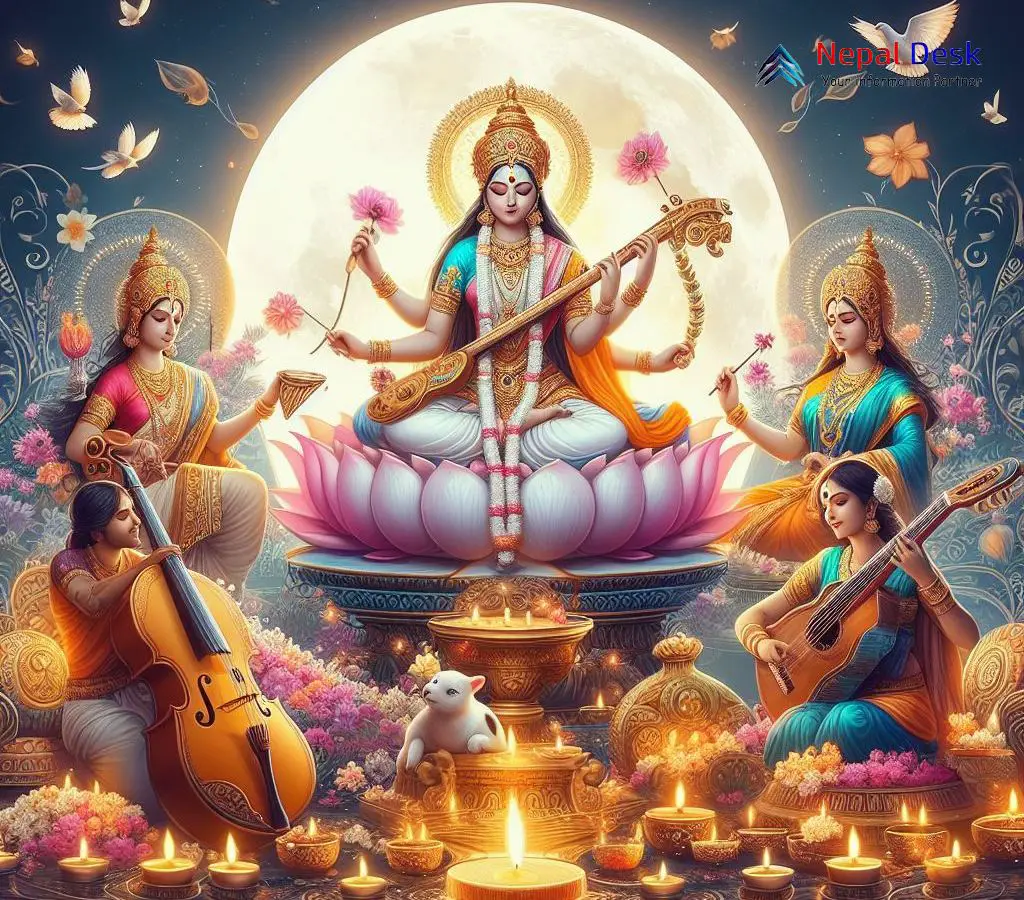Saraswati Puja in Nepal: Symbolism of Knowledge and Unity
Published Date

Published Date
Nepal's Vibrant Saraswati Puja Celebrations: Symbolizing Knowledge, Creativity, and Cultural Unity
⏱ 5 min read
Today, Nepal witnessed a vibrant bloom of radiant yellow hues sweeping homes, schools and shrines as the nation enthusiastically celebrated Saraswati Puja, also termed Basant Panchami, carrying profound resonance beyond geographical borders into diverse Hindu communities internationally connected by shared civilizational heritage.
It falls on the 5th day in the Shukla paksha of the full moon month of Magh, according to traditional Nepali systems, and is a celebration that is way more than routine seasonal habits. Aesthetically, Saraswati Puja is all about the major constituents of supreme knowledge, rich creative expressions and the plenitude of spring representing the fruitful reaping of knowledge.
Goddess Saraswati, who is the principal deity worshipped during this festival, is an embodiment of knowledge, music, poetic eloquence, and artistic excellence – which essentially embodies the holistic concept of enlightened learning through different stages starting from the spiritual realm to the theoretical principles.
Artistic representation pictures goddess in sitting positions on pure white lotus thrones with veena string instruments and books. These two symbols signify how Saraswati is the Goddess of melody and academic excellence.
Hence, the season becomes an occasion for learning in the whole country, not just in the towns and cities with universities, but also in the far Himalayan hamlets where students sing songs to Goddesses and ask for blessings for academic success and abundant creativity.
Many eager learners even donned vibrant yellow attires signifying spring's freshness along with knowledge values. Devotees congregating at heritage worshiping shrines namely the prominent Nirbhayani and Swayambhu temples in Kathmandu are visible fervently offering flower garlands, fruit platters and glowing incense during special Saraswati pujas seeking divine inspiration towards unlocking their faculties fully.
And the celebrations spread further than just educational institutions. In household compounds, vibrant floral rangoli patterns emerge alongside mango leaves and jasmine adornments for home shrine spaces prepared lovingly welcoming the Goddess expected to seed wisdom during her passage. Traditional ritual ingredients of oil-lit lamps, sweets plates and seasonal produce also positioned respectfully while families implore progeny blessings towards fulfilment across artistic or scholastic dimensions prioritizing learning as the ultimate immersive experience.
The Nasal Chowk precincts in the heart of Kathmandu are the place where the "Geeta Govinda" verses are sung in the early hours of the "Basant Shravan" festival that would be concluded by the closing of the day - the Goddess Saraswati's constant bondage to art and creativity thriving in the spring season is thus brought to light
Although the anchoring function continues to be for centuries, during feasts its performance undergoes a gradual transformation on account of different means of externalization, including scholarly analysis as well as the creation of various artistic versions which bring the society to a new level of harmony.
This is why it is essential to note that music, dance and cultural events that permit people to engage beyond mere observation illustrate the creation of new ways to look at learning pathways which may not necessarily be in the books but just as important for further stimulation and encouragement.
Women’s increased presence in the modern-day educational plus professional fields also echoes a bit in unconventional celebrations interpreting the Divine Feminine rather than the traditional Patriarchal narratives.
Kathmandu Valley urban clusters are known for their veneration of the Goddesses; the processions with the iconography of the Goddess, followed by a community feasting that signifies camaraderie, are a part of it. The artistic legacy remains vibrant with the largest festival of Akshaya Tritya Jatra event for the observers, which is the magnificent parade with the chariot-carrying Goddess in the hopes of cascading prosperity after the long ascetic winter months.
Saraswati traditions also adopt localized expressions respecting cultural diversity across Nepal's geographical expanse. In Eastern regions, mustard greens and pink radish harvests are offered to symbolize aspirations for "fruitful knowledge crops" that sustain lifetimes. Down in the sub-tropical Terai flatlands, the spring festival ushers competitive kite-flying escapades spiraling high mirroring hopeful regional sentiments.
The Newar community initiates young children into preliminary learning through "Bala Puja" rituals allowing them to trace first letters upon rice grains - thus inaugurating scholastic journeys for the next generation even as they grasp handfuls of the very grains that shall one day feed families through fruits of education.
However, pandemic restrictions necessitated smaller events, but the unshakable vibe of knowledge could be experienced within small family circles or via the online medium. In this case, the ethereal nature of knowledge proved to be beyond circumstantial barriers.
As Nepal is celebrating, analogous feelings and ideas embedded in the shared civilizational identity of Hindus that are spread globally and only too humanly intertwined over centuries do resonate.
May this spirit reaffirm upon humanity the significance of:
- Learning process through different avenues of study.
- Celebrating the multiplicity of heritage identities respectfully.
- Transformation of the traditions in a very flexible manner without hampering the eternal core values.
Hence, let Goddess Saraswati’s miraculous wisdom drench the minds of people and the communities with hope, joy, and smiling at the thought that brighter times are ahead.
